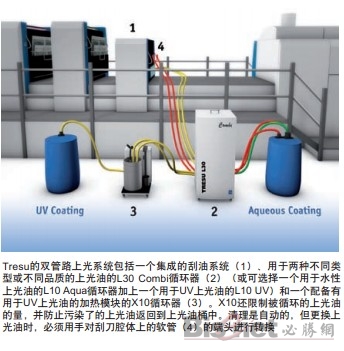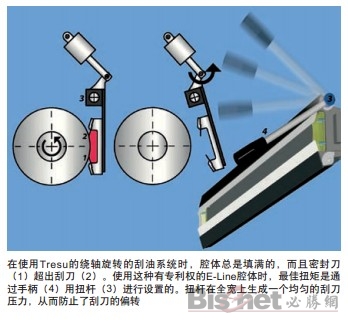Tresu's system: two varnish lines
The Danish manufacturer Tresu began manufacturing squeegee systems for flexographic printing presses in the late 1980s and applied this technology to the on-line coating of sheet-fed printing presses in 1992. The company ’s water-based and UV varnishes use two A separate varnish line. When using this system, the automatic procedure also means that the oil scraping system can remain in the printing press during the cleaning and replacement of the varnish. Varnish delivery and replacement are just two aspects of a comprehensive solution that is also used to deal with typical flexo problems. Tresu provides the entire business of converting standard glazing devices into advanced glazing systems for special applications.
Dedicated or dual-use circulator
Tresu users can choose between a dedicated varnish circulator-L10 Aqua (for water-based varnish) or L10 UV (for UV varnish)-and the dual-use system L30 Combi.
The L10 Aqua Circulator can program many different cleaning cycles. The easiest way is to use hot water, and this method should be specifically used for rapid cleaning between two jobs. At the end of a shift or when changing the varnish, it is recommended to use a more powerful cleaning cycle using hot water and cleaning additives to clean the blade cavity, hose and circulator. The circulator has the ability to program the cleaning method and time, water consumption and temperature, which means that all traces of contamination on the doctor blade and anilox roller will be removed. The L10 UV, which replaces the hot water cleaning system, is equipped with a built-in solvent tank, from which the solvent can be distributed to the doctor blade chamber, hose and circulator. Both Aqua and UV circulators have purification functions.

The L30 Combi, which has a line for water-based varnish and a line for UV, is equipped with four compressed air diaphragm pumps. Two pumps are used for each varnish.
Use two lines to speed up varnish replacement
When using two lines, it is only necessary to remove all traces of varnish in the scraper cavity, but not in all pipes and circulator valves. Therefore, the time required to empty and clean the system is shorter, and the varnish used in the process is less. This shortens both time and cost, and eliminates all the dangers of mixing different types of varnishes or causing mutual contamination from the beginning. The only drawback of this system is that the hoses for water-based and UV varnishes on the doctor blade chamber must be manually switched according to the type of varnish to be used. But this operation takes less than 30 seconds.

The regulator is not just a heating module that warms the UV varnish to reduce its viscosity, which improves its fluidity on the substrate and makes it easier to pass through the diaphragm pump. But Tresu ’s X10 regulator is not just a heating module, because it cuts off the direct delivery of the varnish from the varnish drum to the circulator and limits the amount of varnish circulating in the system, thus making the system more It is heated quickly, and the energy input is reduced. In addition, the contaminated varnish will not be returned to the varnish barrel.
Pigment varnish
An optional stirrer can be installed for X10 to ensure that the particles in the paint varnish are evenly distributed. Pigment particles also increase the viscosity of the varnish, depending on the size and structure of the particles. Although this problem can be easily solved by reducing the pigment concentration, this will naturally weaken the overall quality of the varnish and the optical effects it creates.
Pigmented local varnishing is usually done by varnishing devices using polymer flexographic printing plates. Varnishes tend to accumulate at the edges of varnished areas. If the operator of the printing press wants to maintain a constant good glazing quality, he must be vigilantly monitored, because as soon as he sees the accumulation of glazing oil, he must clean the glazing plate. Tresu's "Plate Cleaning Device" (PPC)-a system for cleaning flexible printing plates during printing production-was specially developed for this purpose. When the press is stationary, a "turbo" system can be used.
Defoamer
The air that caused the glazing oil to foam has no chance to succeed in the E-Line oil scraping system. The cavity is always filled with varnish, so there are no cavitation, and the varnish is pumped through at a high flow rate. If there is air in the applied high-viscosity varnish (this may happen), the air can overflow through a siphon valve that can be activated as required.
The patented torsion bar in the E-Line cavity eliminates all risks of excessive wear or uneven wear that would cause you to have to replace the scraper in advance, and ensures that the varnish is scraped evenly and uniformly across the entire width of the anilox For oil, Tresu's E-Line system uses a torsion bar to close the blade with even torque. This rod replaces the traditional cavity where multiple screws must be fastened simultaneously. Simply release the torsion bar, and the blade can be replaced in seconds.
We have a variety of silicone mold with any shape,such as star\heart\flower\animals etc..Our Silicone Chocolate Mold have below feature: Different Shape Silicone Baking Molds,Excellent quality cake decoration,High food grade material,LFGB,FDA standard, Cake decoration sample supported OEM,ODM are welcomed.
Silicone Chocolate Mold
Silicone Candy Molds,Silicone Gummy Molds,Silicone Lollipop Molds,Fat Bomb Molds
YANGJIANG SHENGHAI INDUSTRIAL&TRADING CO., LTD , https://www.shenghaiyj.com